Tourists again enjoy Tibet high life
Updated: 2023-10-05 By Palden Nyima (China Daily)  Print
Print 


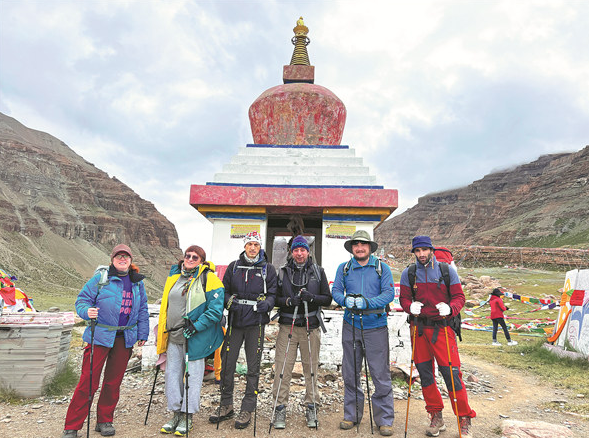
Overseas tourists pose for a group photo at the foot of the Mount Kailash (Mount Gangrinpoche in the Tibetan language) in Ngari prefecture of the Tibet autonomous region. [Photo provided to China Daily]
Region's many attractions, and lifting of pandemic restrictions, entice increasing number of visitors both foreign and domestic, reports Palden Nyima in Lhasa.
Hearing the news that the Tibet autonomous region would reopen to foreign tourists early this year, All Ways International, a US-based travel agency, wasted no time to place advertisements on their social media platforms and contact its clients.
The company organized the first group of 11 foreign travelers for a Tibet tour in late May. They were mostly Russians, or from other European countries, according to Vladimir Poda, a Russian who works as a tourist group organizer for the travel agency.
Poda's first tour of Tibet was in 2013 with a group of around 20 people, most of whom were Russian-speaking from different countries. He has visited the autonomous region in Southwest China as a tourist eight times in the past decade.
"Due to the COVID-19 pandemic, many foreign travelers had to cancel their plans to visit Tibet in the past three years, and some are now eager to tour the region," Poda says.
Tibet suspended inbound tourism in February 2020 in accordance with the policies of the Ministry of Culture and Tourism on controlling the pandemic.
There is an influx of international travelers into Tibet again since the autonomous region reopened to the outside world in April.
More than 13,000 foreign tourists visited Tibet in July, the number increasing by 358 percent year-on-year.
The autonomous region's international tourism receipts exceeded $11 million in the first half of this year, up by 364 percent over the same period of last year, according to Tibet's tourism development department.
As the application process for a visa becomes less difficult, more overseas tourists are choosing China.
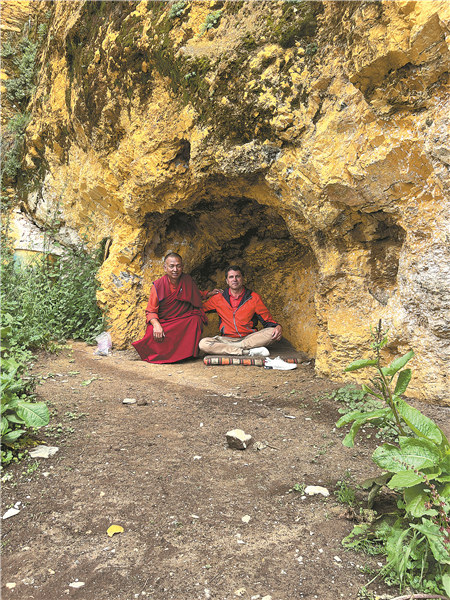
Vladimir Poda, a Russian tourist visits the Drakyerpa Monastery near Lhasa, the capital of the Tibet autonomous region. [Photo provided to China Daily]
The autonomous region attracted more than 11,000 foreign tourists and had a total revenue of over $78 million from overseas travelers in 2019, a rise of 53 percent and 44 percent respectively over 2018.
"Currently, the number of inbound tourists from Nepal visiting Tibet has reached the same level as pre-pandemic 2019 figures, but the number of inbound tourists from other countries and regions is fewer than before the pandemic," says Dekyi, an official of the local tourism department.
International tourists visiting the autonomous region come from more than 70 countries, including Nepal, the United States, Malaysia, Vietnam, Germany, Japan and the United Kingdom.
"Most overseas tourists like to tour places with unique features of Tibetan culture, such as the cities of Lhasa, Shigatse, Lhokha, and the Ngari prefecture," Dekyi says.
She adds that overseas travelers have to go through approval procedures to visit Tibet. The application processing time for the permit has been cut to about three days, compared to more than a week before 2020.
"Our department has been coordinating with other departments to build a platform to supervise the autonomous region's inbound tourism," she says.
Dekyi calls the platform a "breakthrough", which helps the local authorities significantly shorten the time to process international tourists' application procedures to visit Tibet.
"It has effectively helped inbound travel agencies to ease the problem of long-cycled certification," she adds.
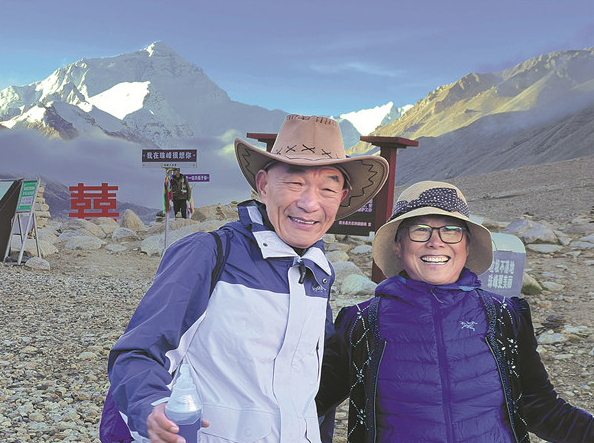
Tourists pose for a photo in Tibet's Dingri county at the foot of the Mount Qomolangma. [Photo provided to China Daily]
Future fast growth
Yang Yong, general manager of the Tibet Vista Tour, an international travel agency providing tourism services for both inbound and domestic tourists, says that his company expects to receive 2,000 overseas travelers this year, and the overseas tourists his company has received so far this year are mostly foreigners who work and live in China.
"The proportion of overseas tourists who made trips to the region from outside China is relatively small," Yang says. "Most overseas travelers whom my company has received this year were mainly from Europe, the US and Southeast Asian countries."
Yang says that his company expects to have 25 percent of the 8,000 tourists it had dealt with in 2019, as the recovery of flights is slow, and the process of applying for a Chinese visa is still difficult.
"Most overseas tourists have a positive impression about touring in Tibet," he says, adding that there are still complaints; for example, some are unhappy with the toilets at the tourism sites.
Yang says that his company provides hotel reservations, food, transportation, tickets, tour guides and document processing.
He says that foreign tourists choose to go to Mount Qomolangma, commonly referred to as Mount Everest in the West, in the autonomous region's city of Shigatse, and they also like to go to western Tibet's Ngari prefecture and the scenic routes linking with attractions in Nepal.
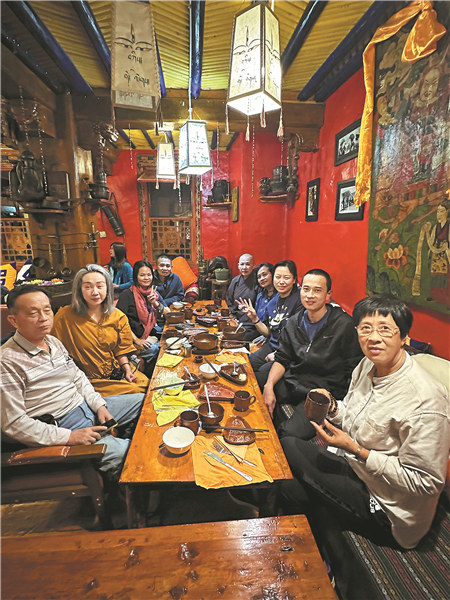
Overseas and domestic tourists enjoy a meal in a Tibetan restaurant in Lhasa in May. [Photo provided to China Daily]
More income for insiders
Jamyang Tsering, a Tibetan tour guide who speaks German and English at the Tibet Vista Tour, says that, with the number of overseas tourists rising this season, his monthly income has doubled.
Before April, he could only earn an average of 6,000 yuan ($827), and his monthly income increased to more than 13,000 yuan thanks to the influx of international travelers.
Jamyang Tsering finds that many overseas tourists feel safe traveling in Tibet, and they also like the food of the region as there are always multiple options available.
"I also find that many overseas tourists are really surprised with the overall developments of the region, and many did not expect that much development before they came," says Jamyang Tsering, adding that most of the Western tourists love to visit Mount Kailash, the Potala Palace, and the ruins of Guge dynasty founded in around AD 912 by Kyide Nyima Gon, the great grandson of the Tubo ruler Langdarma, with its capital in Purang, more than 1,500 kilometers from Lhasa.
"Some guests are more interested about religious cultures of the region, such as the Drigungthil Monastery, and others prefer to go to rural places to see how local people live, dress themselves and practice their religion," he says.
Due to the pandemic, inbound tourism has been suspended for three years, and after reopening services again, many foreign guests are very excited to have the opportunity to visit the region, Jamyang Tsering adds.
Choedhar, a bilingual tour guide in Lhasa, says that, since April, the number of overseas tourists has been increasing, especially the number of the foreigners who work or live in China visiting Tibet.
"For me, I guided many European travelers this year, and I have found that many of them are more interested in the Tibetan traditional culture rather than visiting only for sightseeing," says Choedhar.
"Different sectors of the autonomous region have been making efforts to make it easier for overseas tourists to visit Tibet," Choedhar says, adding that foreign visitors can now find the right tour guides who speak their languages.
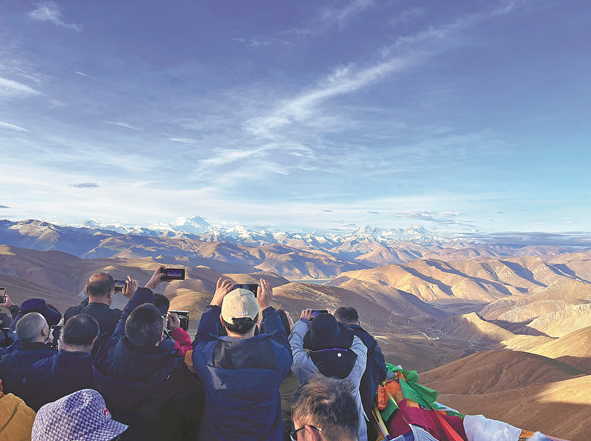
Visitors photograph the stunning scenery of Mount Qomolangma in Dingri county. [Photo provided to China Daily]
Admiring the spiritual culture
Poda of All Ways International says that, in this season, the travel agency has brought almost the same amount of foreign tourists to Tibet as it did in 2019.
One of the groups Poda organized arrived in Tibet on Aug 8.
Poda says he met his business partners in Lhasa to reactivate their cooperation, and he also guided a group touring in the region.
This group had 21 tourists mostly from Russia.
These people were divided into two groups, with one guided by a Tibetan guide, who speaks Tibetan and English, and the other guided by Poda, who speaks English and Russian.
"We visited the Potala Palace, the Jokhang Temple, and the Drakyerpa Monastery in the past couple of days, and we also visited a Tibetan village to get a glimpse of local people's life," he says.
"What I like the most are the Jokhang Temple and the Potala Palace in Lhasa. I like them very much," he says.
Poda adds that he prefers to live in a simple hotel rather than a fancy one, as long as the hotel is at a good location to observe the ancient cultures of Tibet.
"We just visited Drakyerpa. There are many meditation caves, which meant a lot for me, because I practice meditation and yoga," he says.
"I also like to worship the sacred Mount Kailash, as the Tibetans and the Indians do."
Pilgrims of several religions believe that circumambulating Mount Kailash on foot is a holy ritual that will bring them good fortune.
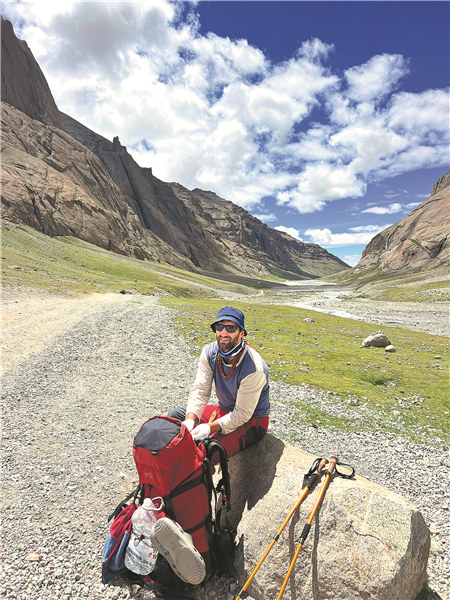
A foreign tourist at the foot of the Mount Kailash in Ngari prefecture. [Photo provided to China Daily]








